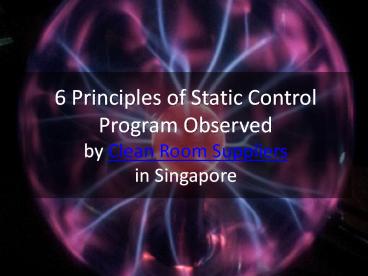The Six Principles of Static Control Program - PowerPoint PPT Presentation
Title:
The Six Principles of Static Control Program
Description:
In the environment of electronics manufacturing, controlling electrostatic discharge (ESD) is very challenging. But if the decision makers learn how to focus on the six principles of static control program, the design and implementation tasks will be less complex. Read more about it here! – PowerPoint PPT presentation
Number of Views:65
Title: The Six Principles of Static Control Program
1
6 Principles of Static Control Program Observed
by Clean Room Suppliers in Singapore
2
In the environment of electronics manufacturing,
controlling electrostatic discharge (ESD) is very
challenging. But if the decision makers learn how
to focus on the six principles of static control
program, the design and implementation tasks will
be less complex. Therefore, assigned personnel
must keep in mind the Murphy's Law, which states
that no matter what we do, static charge will
try to find a way to discharge.
3
The Six Principles of Static Control Program
4
Protection of the design.
5
The first principle is related to the assemblies
and products' design that aims to be as resistant
as reasonable from electrostatic discharge
effects. The steps involved to achieve this
principle include the use of devices that are
static sensitive or by giving the proper input
protection on devices, equipment, assemblies and
boards.
6
For designers and engineers, the paradox of this
first principle involving ESD protection
equipment is that product development needs
geometries that are smaller yet more complex and
are usually more susceptible to ESD.
7
Identification of the needed control in a
particular environment.
8
To identify the required level of control, it is
good to know the Charged-Device Model (CDM) and
the Human-Body Model (HBM) sensitivity levels for
all units that will be handled in the
manufacturing environment like the ESD
workstation. Through proper documentation, the
two identified standards will allow requirements
to be adjusted as appropriate for particular
scenarios.
9
Electrostatic Protected Areas (EPA) definition
and identification.
10
As per the definition of the glossary, the area
that is ESD protected is "A defined location with
the necessary materials, tools and equipment
capable of controlling static electricity to a
level that minimizes damage to ESD susceptible
items." This means that you'll handle the
sensitive devices in these areas and that they
are also the location where the ESD control
procedures will be implemented, from personnel,
electrically connecting or bonding all conductive
and dissipative materials, to a known common area.
11
Reduction of electrostatic charge generation.
12
In this fourth control principle, the idea is to
lessen the generation and accumulation of
electrostatic charge. Basically, it is no charge,
no discharge rule. Start with elimination, as
many static charge generating materials or
processes as possible from the work environment
of Electrostatic Protected Areas (EPA). As you
control the static electricity to a certain level
with less damage using the basic principle,
charge generation complete removal will still not
be achievable.
13
Neutralization or dissipation safety.
14
Since total elimination of electrostatic charge
in the EPA is not possible, this fifth principle
aims to safely neutralize or dissipate those
electrostatic charges that do exist. The use of
dissipative or conductive matters and right
grounding play important roles. Do further
research for samples including on LDPE plastic
bags. Going back, this shows that the use of
static dissipative materials can control the
magnitude of the discharge current to avoid
damaging a charged unit.
15
Product protection
16
Lastly, this principle aims to avoid discharges
that do happen from reaching susceptible
assemblies and parts. First way is to protect
products by proper grounding. The other way is to
put sensitive items in packaging that are
conductive and low charging to remove charges
when grounded.

